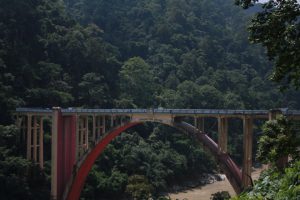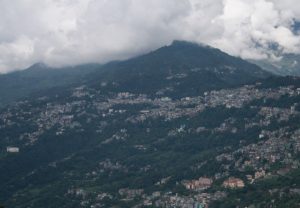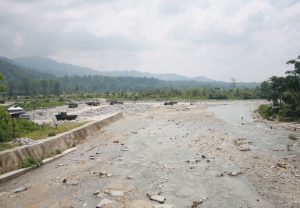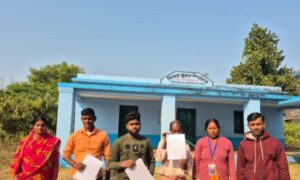
By Rituparna Borah
Just three days in a place like Sikkim and that too in the rainy season didn’t quench even a speck of my thirst for the beauty I encountered. Surely another trip is due and next time I’ll stay for a longer duration. But my observations while travelling around the place and my word with a knowledgeable local man led me to a lot of pondering, which, it seems is going to culminate into another post in my blog.
I had been hearing and reading a lot about Sikkim off late; especially about the Kanchenjunga Landscape Conservation and Development Initiative (KLCDI) taken up by ICIMOD (International Centre for Integrated Mountain Development), based in Nepal, and assisted by Indian institutions like the GBPIHED (Govind Ballav Pant Institute of Himalayan Environment and Development). A large part of Sikkim (in fact, almost the whole of it) falls under the Kanchenjunga Landscape. So, when I got a chance to visit Sikkim (I was to accompany a family member) I took it.
Transboundary Ecosystem Management is a growing need of the world. During the present UN Decade for Biodiversity, the focus has been largely placed on conservation of biodiversity through ‘ecosystems approach’. Sustainable development strategies, of any country, work
closely with such approaches and thereby help neighbouring countries manage the transboundary ecosystems. Evidently, India is scoring behind on this front, because, from what I observed in Sikkim, tourism remains the main source of revenue for the State, leaving oodles of loopholes in all-round development of the region; for unchecked growth of this industry poses a potential threat to the astonishing biodiversity of the Eastern Himalayas.
Incredible India’s tag for Sikkim as ‘Land of peace and tranquillity’ is totally germane to my feelings about the place. Beyond Gangtok and a few smaller town-like areas, the hills are an epitome of silence; the gurgles of numerous springs, creeks and rivulets, which feed the mighty river Teesta, being the only sound invading it. The area around Banjhakri Falls, once upon a time, pervaded by people of Shamanistic beliefs (as the word ‘Jhakri’ means a shaman in Nepali) like many other places in Sikkim, preserves the feeling of mystery that is associated with nature. In the four districts, namely East, West, North and South Sikkim, many hamlets have been turned to village eco-tourism sites by the government. Although most of the hilly terrains are uninhabitable and lack instant communication facilities, almost every thirty-forty kilometres one can find a place to stay and enjoy the peacefulness of the hills.

The Hub of Sikkim: Gangtok. Gradually Growing
I had a chance to see some places in North Sikkim, from Gangtok to Dzongu and places in and around Rumtek and Ranka. In a one-liner: Sikkim is nature per se.
Rivers and Routes
The beautiful Teesta which originates from the Himalayan Glaciers and glacial lakes like the Mansoravar and Gurudongmar, runs along the winding road from NJP (New Jalpaiguri) to Sikkim, flowing between two hill ranges initially which are conjoined by the more-than-a-hundred-years-old Coronation Bridge (built by the British to join the Jalpaiguri and Darjeeling districts of West Bengal) and then as one moves north towards Sikkim, the river is found flowing southwards making its way through the gorges and ravines in the mountains. At some places, it’s just breathtaking! A major tributary- Rangeet meets Teesta at a point near Kalimpong called Triveni. Both the Teesta and Rangeet are great sources of hydropower for the States of Sikkim and West Bengal. On the way to Sikkim, one can even have a glimpse of the Teesta Low Dam Project (TLDP) under construction at Kalijhora, a few kilometres ahead from Sevoke in West Bengal.
The route is mostly large enough for two way traffic, yet perilous at some parts like narrow turns; landslides zones during the monsoon and shooting stone sites. Such condition of the road and the unwieldy traffic at rush hours is bound to leave one wondering about the true state of development in West Bengal and Sikkim.
Therefore, the only aspect to savour during the journey is the river Teesta and its wonders. A look at the road topped by some rash driving at such heights and all enthusiasm of journeying to Sikkim is lost!
Village Eco-Tourism
Having stayed and roamed around mostly in the plains, I’ll never cease wondering how people manage to build houses and form communities in such inaccessible areas in the hills. The tiny hamlets spread across the hill ranges are another wonderful sight in Sikkim. The Central government and Sikkim government has indeed taken a constructive step by funding and directing the villagers to develop village tourism, including home-stay facilities, organic farming and showcasing of unique cultural elements. The lack of instant and constant communication is a major hindrance in the fast development of such remote areas but ‘fast development’ shouldn’t be left unquestioned; so, I am quite satisfied regarding the way things have turned out for these villagers. At least they can now afford quality education for the younger generations. Previously subsistence farming was the only source of livelihood and the existence of another world beyond the community was not known to these people. However, with the advent of organic farming and the home-stay business, they are growing more aware day by day and are being exposed to new avenues of trendy businesses in the nearby towns and cities.
Nevertheless, excessive spotlight on tourism cannot secure the future of these people who fall behind by decades compared to their foreign counterparts whom they serve in the home-stays.
Construction or Destruction?

Construction Work Close to Tista River
While journeying to Sikkim, one is bound to come across queues of monkeys waiting to be fed by the travellers on the route. When even monkeys turn to the mercy of tourists for food, instead of fending for themselves in the wilderness, maybe it’s high time for the government to reconsider their steps for the development of the region?!
Despite the initiatives of community participation in tourism through developing village eco-tourism sites, the mass tourism industry still reigns in the region. And despite the sector’s fair share in the socio-economic development of the region, one cannot overlook the negative impacts of excessive emphasis on tourism.
Tourism, obviously, is not helping the environment in any way, for the environment is best left untouched.
As regards to the people, I had a talk about the actual scenario of the tourism business with an ex-army man, a 68 years old retired person, who now serves as a driver and a guide for the tourists. According to him, it’s the high handed people and the middle-men who enjoy the profits from the tourism industry. They have even carved out ways to exploit the village eco-tourism business meant for the benefit of the local people and the environment. No doubt the local people get a minor share of the benefits, nevertheless, he is worried about the future generations because professional education like hotel management, retail and professional driving are gaining more importance among the local youth (and in fact, is encouraged by the present Chief Minister) than higher education which empowers one with the ability to think, act wisely and devise better policies. The more tourism gets importance, the more nature is exploited for construction purposes, thereby expending more natural resource than nature can bear.
Poor governance is inadvertently supporting the construction of huge buildings on the loose hilly soils. Landslides during monsoons are getting frequent owing to the loosening of the ground. On top of that, most people from villages aspire to own a place near the major cities like Gangtok and Pelling to enjoy the fruits of mass tourism business and in doing so keeps on adding to the burden to an already vulnerable topography.
Also, village eco-tourism is hardly carried on with a focus on the particular environmental demands of the place and are developed more on a homogeneous line, with a perspective to serve tourists’ needs. Effective village eco-tourism can be gained only by a community participation which is holistic, that is if it covers all the arena of economic development. Simply accommodating tourists, giving them package tours and serving them food from organic gardens is not enough. It might help people earn the survival needs but in a place like India, which does not get many travellers and where long monsoons often prevent tourists from reaching these villages, community participation is also required in promoting other skills, which are inherently cultural like weaving and preparing herbal products.
Small scale industries must be encouraged along with community eco-tourism. Teesta and Rangeet being majestic rivers, with a perennial source of water, are viable sources for hydroelectricity for supporting the small scale industries. The positive part of hydro electric projects midst hills like the Teesta V-Dam is that they often assist in controlling floods unlike their counterparts in the plains.
Tailpiece:
As I said: Sikkim is nature per se. At least as of now, it’s a treat for the senses and the soul. I am quite sceptical about the future though. According to me, the two major errors in managing this wonderful Kanchenjunga Landscape is not paying enough importance to 1) local governance and lack of stringent rules regarding construction 2) small scale industries, that is, exploiting the much needed human resource along with the natural resource.
Neither the humans should be left to the mercies of nature nor should nature be left to the mercies of humans: sustainable development is that where human and nature mingle in a fruitful manner and is not mutually exclusive.
I would say there’s a large scope for more research on the implementation of tourism projects so that they do not function in contradiction to initiatives like that of KLCDI.
Hopefully, I get a second chance to visit Sikkim… so more tales from the Himalayan backwoods are due!

Brief Bio:
Rituparna Borah is a research fellow at Madras Institute of Development Studies (MIDS), Chennai where she is pursuing research on eco-tourism. Her areas of research include political ecology, natural resources management, and community participation. Apart from these, cinema, cultural studies, and Indian philosophy also appeals her.
(The article first appeared on Halfnotes. To read the original article click Here.)


















